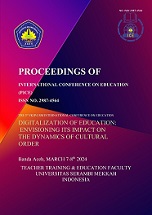HUMAN-CENTERED AI IN LANGUAGE CLASSROOMS
Main Article Content
Abstract
This qualitative case study investigated how teachers and students at senior high schools in Banda Aceh experience the integration of artificial intelligence (AI) tools in classroom-based language learning. Adopting a human-centered perspective, the study addressed two primary questions: (1) how do teachers navigate their roles when integrating AI into classroom instruction, and (2) what are students’ experiences of receiving AI-generated feedback in a teacher-guided learning environment? Data were collected through semi-structured interviews with English teachers, Focused-Group Discussions (FGDs) with students, and classroom observations. Thematic analysis was applied to identify emerging patterns across data sources. The findings indicate that teachers serve as facilitators, interpreters, and ethical decision-makers in the use of AI, consciously adapting AI-generated feedback to suit student abilities, classroom dynamics, and instructional goals. While they value the efficiency and personalized support AI offers, teachers remain central in guiding students through the feedback and ensuring pedagogical alignment. Students generally perceive AI feedback as helpful, especially for grammar and writing tasks, yet they often rely on teachers to clarify or validate the suggestions. Their confidence and motivation in using AI tools increase when teachers provide clear guidance and frame AI as part of an interactive learning process. This study affirms the importance of a human-centered approach to AI integration in education, where technology enhances—not replaces—teacher-student interaction. The study recommends targeted teacher training, collaborative AI design, and policy support to ensure ethical and meaningful classroom implementation. Its limitations include a single-site focus and non-generalizable scope.


